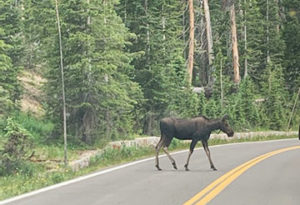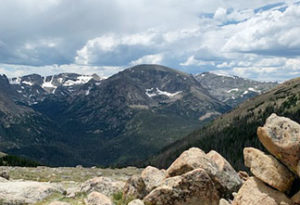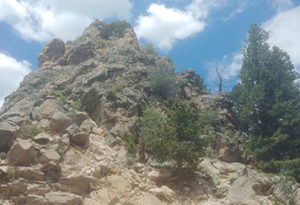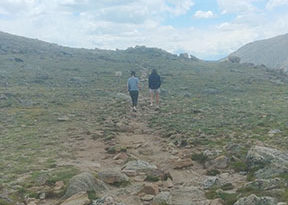By Eric Freedman

Moose ambles across a road in the national park. Image: Kalie Buchman
I recently beat Ivanka Trump to Rocky Mountain National Park by a few days, but our purposes for being there were dramatically different.
For Trump, the 358-square-mile natural treasure was a mere backdrop to laud embattled U.S. Sen. Corey Gardner, the Colorado Republican who successfully sponsored legislation to provide more funding for the cash-strapped national park system and other federal lands. He’s up for reelection against John Hickenlooper, a former Democratic governor.
Congressional passage of the bipartisan money bill provided a time peg for the visit by the president’s daughter and Interior Secretary David Bernhardt.
Trump said in a statement from the White House, “Working with Sen. Gardner on the Great American Outdoors Act, we are securing funding for the next 100 years to preserve our national parks and public lands.”

Mid-summer patches of snow high in Rocky Mountain National Park. Image: Kalie Buchman
The spending bill is intended to reduce a massive backlog of maintenance projects for the National Park Service, U.S. Forest Service, U.S. Fish & Wildlife Service, Bureau of Land Management and Bureau of Indian Education. It also will provide permanent and full support for the Land and Water Conservation Fund.
Last year, the Pew Charitable Trusts, a nonprofit research organization, reported an $11.9 billion maintenance backlog at national parks. That figure did not include the cost of maintenance backlogs at the other federal agencies that will benefit from the new funding.
Backcountry Hunters & Anglers, one of the advocacy groups pushing for the new legislation, called it a “once-in-a-generation opportunity to fund conservation and access in the United States” and “an overdue investment in some of our most critical fish and wildlife habitat.”
At the July 23 election season photo op, Trump told an audience of invited guests and park rangers. “It is especially timely, in light of COVID, that we were able to sign the farthest-reaching conservation legislation since Theodore Roosevelt over 100 years ago.”
Her appearance follows years of harsh criticism of the president’s public lands policies.

Rocky outcrop at Rocky Mountain National Park. Image: Eric Freedman
As one group, the National Parks Conservation Association put it: “President Trump and the officials he has appointed have systematically undermined, degraded and outright attacked the laws that protect our public lands, the agencies that manage them and the irreplaceable resources these places safeguard for the American people. The few bright spots are unfortunately significantly outweighed by the deliberate disregard for the future of our public lands.”
One of the president’s most controversial public lands moves came in 2017 when he issued proclamations that would remove federal protections from about 2 million acres of land in Utah’s Grand Staircase-Escalante and Bears Ears National Monuments, which are part of the National Park Service.
By contrast, I can summarize the reason for my recent Rock Mountain National Park visit as the real – a/k/a nonpolitical – “great outdoors” – the female moose that ambled across the road in front of us, the bighorn sheep high on a snow patch that lingers in mid-summer at high altitude, the vistas, the winding drive above the tree line.
During these pandemic times, national parks offer spectacular destinations for getting out of the house. Not surprisingly with so many other recreational opportunities closed because of COVID-19, lots of people have the same idea.
Our past summer trips to Rocky Mountain National Park were marked by crowded roadside viewing spots, tourist-jammed visitor centers and lines of impatient drivers navigating Trail Ridge Road.

A pair of hikers have a portion of a trail above the tree line to themselves. Image: Eric Freedman
It’s the third most-visited national park with more than 4.6 million visitors in 2019, and almost 1 million of them in July alone. As the park puts it, “Visitors experience a high level of congestion in many areas of the park from late May through early October.”
Not so this year.
The park now limits admission to vehicles with “timed entry permits” obtained through an online reservations system – required even to simply drive across the park between the mountain communities of Estes Park and Grand Lake – thus controlling the number of visitors to promote social distancing. Some camping areas are closed too.
The permit requirement limits vehicles to 60% of the park’s maximum parking capacity, roughly 4,800 vehicles or 13,500 visitors daily. That works out to about 418,000 visitors this July, or less than half of last year’s July visitation.
And while the restrictions do prevent hundreds of thousands of visitors from experiencing the glories of Rocky Mountain National Park – at least for now — they enhance the outdoors experience of those who get in. We crossed paths with only two other hikers on one short trail and experienced no traffic jams. We shared that moose sighting with the folks in only a few other cars.
And yes, the mountains themselves remain majestic.
Eric Freedman is the director of Michigan State University’s Knight Center for Environmental Journalism.

Definitely a majestic thing to witness. We have to do everything in our power to preserve it that way,